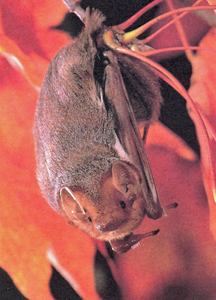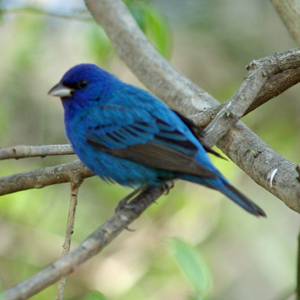Bats of Iowa
Vespertilionidae
Lasiurus borealis (Muller)
Red Bat

Etymology
Greek: Lasiurus -"hairy tail." Latin: borealis-"northern."
Appearance
Fur: Red-orange (females with frosty appearance); hair - dark base,
broad yellow band, narrow red subterminal band, white tip (more
prominent in females).
Tail Membrane: Completely furred dorsal surface.
Wing membrane: Black; furred from body to elbow and along forearm.
Calcar: Keeled.
Ears: Short (14 mm); lower exterior furred, tip and interior nearly
naked; rounded tip.
Tragus: Clearly less than one-half ear length; rounded tip; curved
forward. .
Total length: 93-115 mm. Forearm: 34-45 mm. Wingspan: 290-323 mm.
Total weight: 6-14 g.
Dental formula: 32 total; I 1/3, C 1/1, P 2/2, M 3/3.
Confusing Species
Hoary bat (L. cinereus): Larger size (>15 g) and longer forearm (>45
mm); not reddish in color.
Distribution and Status
Overall: Southern Canada, all U. S. (except Rocky Mountains) to
Argentina and Chile.
Iowa: Statewide summer resident (both sexes).
Natural History
A solitary rooster, the red bat can be found during summer daylight
hours in dense clusters of leaves in wooded areas throughout Iowa;
generally on the south side of trees next to fields or streams or in
urban areas. Red bats emerge in the early evening to forage for a
variety of insects, including crickets, flies, bugs, beetles,
cicadas, moths and planthoppers.
Although adults of both sexes occur in Iowa, females seem to
outnumber males except in August and September when mating occurs.
As with several other North American bats, however, actual
fertilization may not occur until spring. In Iowa, from 1 to 4 young
are born by late June or early July, but details of birthing and
growth of the young are poorly documented.
Spring migration probably begins in April, while fall movement
through Iowa ends by October. Since the species has been reported to
forage during near freezing temperatures, it is able to survive low
temperatures that may occur during migration. Although none have
been found in Iowa in winter, red bats possess several anatomical
adaptations that allow survival at low temperatures. These
adaptations include the heavily furred tail membrane and short
rounded ears with a minimal surface area for heat loss.
Even though red bats rarely enter buildings, they rank third in
numbers sent in for rabies analysis. Unfortunately, females burdened
with nursing young often are jarred from tree foliage during summer
thunderstorms and sent in for rabies analysis, rather than being
left alone.
Red bats are common throughout Iowa in the summer and do not appear
to be in any danger of immediate population decline. However,
because they are foliage roosting bats, it is important that ample
forest habitat be maintained in the state.

.jpg)
